

The bones of the oldest man (in fact a woman) to have been found in Britain, lived along the Thames perhaps a quarter of a million years ago. Her skull was found in the gravels in Swanscombe on the south bank of the Thames in north Kent.
There is evidence that the earliest of man wandered into Britain across Europe from Africa about half a million years ago, crossing from Africa to Spain across land that then spanned the Straits Of Gibralter. These people, known as Chellean man, lived in small communities probably in trees in river valleys or in caves along the sea shore. They used the earliest of shaped tools formed from flintstone chipped to a jagged edge following the natural contours of the stone. Chellean axes have been found in the Wey Valley, one of the lower tributaries of the Thames, and no doubt he wandered into the Thames valley itself. Chellean man was around for some 300,000 years.
He was succeeded by Acheulian man who was a better craftsman than his predecessors. He gave his flint axes a straight cutting edge which made them more efficient. This period spanned about 65,000 years.
 |
Hand axes, believed to date from this period, have been found in the Thames Valley near Sutton Courtney, Abingdon, Crowmarsh Gifford, Radley and Wallingford. |
Stone Age Man and some of his Tools |
These relics indicate that early man settled in the Thames Valley before the onset of the last glaciation period and it is quite conceivable that some of these earliest settlers made their way up the Thames on simple log rafts or dugouts.
As glaciation became more severe and life in the Thames Valley grew more difficult, primative man retraced his steps and returned from where he came. It must be remembered that at that time Britain was still connected to continental Europe (See The River Thames - Its Geology, Geography and Vital Statistics)
With improvements in climate after about 10,000 BC, the River valleys again became attractive to settlers. About this time there was consderable movement of people from western Asia into Scandanavia called Maglemosian. They were skilled with boats and it was probably relatives of thes people that made their way into Britain across the Rhine, up the Thames to Reading and along the Kennet to Thatcham where a large settlement of these peoples have been found. It seems that this settlement was in use for about 1000 years from 8400 BC to 7500 BC.
Around 6500 BC, Britain was finally severed from continental Europe, but exactly how the next wave of settlers reached the Thames Valley is unknown. It is however known that these people brought with them improved techniques for making flint implements, pottery and other domestic skills. This culture is known as Neolithic (New Stone Age) Man. They probably originated from the Mediterranean area and travelled through France and finally landed in England along the beaches of the south coast. They found their way from the coast through Dorset and Wiltshire into the Thames Valley where they cleared forests and dense undergrowth and began to plant crops.
Whilst there are very few remains of these early settlements, a picture of life at that time can be pieced together from a group of finds at Abingdon. In this early Neolithic settlement, a number of grain storage pits and traces of cooking hearths, with pots and bones around them, have been found. The specimens found show that these people had an advanced skill in crafting flint including arrowheads, polished axes, knives, scrapers and the blade of a flint sickle.
As the Neolithic period merged into the Early Bronze Age around 2000 BC, the next wave of settlers made their way from Spain into the Low Countries and from there, by sea, into the Thames Estuary and up the River. They were called Beaker people from the pottery they brought with them. They also brought bronze and gold and knew how to work them. This knowledge of metals increased the range of skills and trade.
A number of Bronze Age sites and artifacts have been discovered along the banks of the River including settlements at Lechlade, Cookham and Sunbury-on-Thames.
From 500 BC, the Iron Age Celts from Gaul crossed the Channel, sailed up the Thames and spread throughout the Country bringing with them new iron weapons and tools but they did not come peacefully.
 |
One of their early settlements has been found at Wittenham Clumps near Dorchester but this bronze Celtic shield was found in the River Thames at Battersea. It has had the enamelling restored. |
In the last centuaries BC, powerful Belgie tribes crossed the Channel. The Catuvellauni tribe established themselves on the north bank of the Thames as far as the River Cherwell, and by conquering the Trinovantes, in what is now Essex, took control of the north bank of the Thames Estuary. Another Belgic tribe, the Atrebates, pushed up from the south coast and made there settlements south and west of the Thames. But these tribes did not have it all their own way. In the Thames Valley above Oxford, the non Belgie people, the Dobunni, held on to their land by resisting attempts by both the Catuvellaunis and Atrebates to take over their territory. The Dobunni were to do well out of the Roman Conquest that followed as they were non Belgie, hostile to the Catuvellaunis and Atrebates and accepted the Romans as allies rather than conquerors.
 |
Julius Caesar |
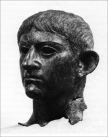 |
Emperor Claudius |
It was the Romans however, first commanded by Julius Caesar in 55 BC and later by the Emperor Claudius in AD 43, who probably first recognised the River's strategic and cultural importance. They called it Tamesis. They built fortifications along the Thames valley from Cirencester to the Estuary with a major camp at Dorchester (which they called Dorcicon). This camp was overlooked by the early Celtic settlement at Wittenham Clumps on the twin hills of Sinodun ('dun' is Celtic for fort).
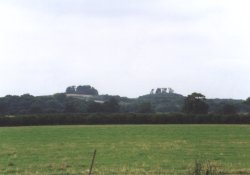 |
Twin Hills of Sinodun |
The Romans also had a camp on the site of the Tower of London.
It is thought that the Romans bridged the Thames in London in c.AD 50, on the site of the first stone Bridge built in 1176 (this was the only bridge to cross the Thames in London until 1749) and Staines (which they called Pontes after the bridge) but the great Roman roads Watling Street, Fosse Way, Ermine Street and the improved Icknield Way also crossed the Thames but as fords. The Romans were also the first to develop the Thames as a major trade route and laid down the foundations for the Port of London which by the nineteenth century had become the largest in the world.
The influence of the Romans began to wane in the middle of the fourth century and in c.AD 367 the Saxons raided England and penetrated the Thames as far as Dorchester. In AD 411 the Romans left and the Saxon raids intensified and as they settled they established hamlets all along the Thames.
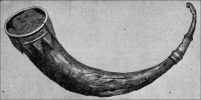 |
 |
A Saxon drinking-horn found at Taplow by the Thames |
A Saxon bronze stoup found at Long Wittenham |
During this period, St. Augustine landed in AD 597 on The Isle of Thanet having been sent to England by Pope Gregory to convert the country to Christianity which led, in less than a century, to the initial founding of the great Thames-side monasteries of Chertsey (AD 666) and Abingdon (AD 675). In AD 635, St. Birinus was sent from Rome to Wessex where he met Cynegils, King of Wessex, at Dorchester and baptised him in the Thame or Thames, thus bringing Christianity to Wessex. St Birinus set up his see at Dorchester where he built an Abbey but only the Abbey Church remains today.
Despite later invasions by the Vikings (Danes), who in AD 870 penetrated the Thames as far as Reading, the Thames is still largely a Saxon River. This Saxon influence can still be recognised today as Sonning, Reading and Goring are all named after some of their leaders (the suffix 'ing' being short for 'inga' meaning 'of the family, clan or tribe of...'). The words 'Weir' and 'Eyot' are also of Saxon origin. For a list of the meanings of some place names along the Thames, take a look at The River Thames - The Meaning of Place Names.
This Saxon influence is mainly attributable to Alfred the Great (considered to be the first King of England) who formed a defensive line along the river from where, in the 870's, he fought the Danes to a standstill. In AD 878, the Danes withdrew to East Anglia and agreed by treaty to stay north of the Thames and out of London. King Alfred died in AD 899 following which the Danes made further raids along the River and reached Oxford and by AD 1014 the Danish King Cnut was ruling England.
It was not difficult for the Anglo-Saxons, Danes (and later the Normans) to live together. One of the first things Cnut did was to hold an assembly in Oxford at which it was agreed that the laws and customs of the Anglo-Saxons should be recognised south of the River Thames and Danish law to the north.
This was not the first time that the Thames provided a border. It was the border between the Belgie tribes of the Catuvellaunis and the Atrebates prior to the Roman Invasion. In AD 600 it was the border between Wessex and Mercia, with Wessex to the south and Mercia to the north.
 |
William the Conqueror |
In 1066, William of Normandy ( William the Conqueror) landed at Pevensey and after ransacking the Thames-side town of Southwark, marched his army along the south side of the Thames to Wallingford where he crossed into Oxfordshire. The Normans were practical and with their stone buildings, brought further developments. They built major fortresses along the River with castles at Wallingford and, perhaps more notably, Windsor and the Tower of London.
 |
A Second World War Pill-Box |
In subsequent centuries the defence of the Thames against European invasion has always been a priority. The Tudors and Stuarts expanded the defences further but this did not stop the Dutch invasion up the Rivers Thames and Medway in 1667.As late as 1940 further defensive measures were taken by the building of a chain of some 5000 Pill-boxes along the River, from the Kent coast at Chatham to the west coast at Bristol, as a defence against a possible German invasion.
The geographic importance of the Thames has always been recognised by the Christian Church and Abbeys, Monasteries and other religious buildings were built along its banks including those at Lechlade, Oxford, Abingdon, Dorchester, Reading and Chertsey. Until the dissolution of the Monasteries by Henry VIII in 1536, they played an important role in the economic development of the River.
During the Civil War (1642-48), which was essentially one of skirmishes and sieges rather than major battles, trade up the Thames was severely disrupted. Although some regions of the country saw little fighting, others were constantly marched over and occupied by rival armies.
 |
The Thames Valley was amongst the worst as Oxford was the seat of Charles I and his Royalist Court (the Cavaliers) and Reading was occupied by the Parliamentarians (the Roundheads) led by Oliver Cromwell. A number of the bridges crossing the Thames were fought over by the two factions. |
 |
Charles I |
Oliver Cromwell |
Although the commercial exploitation of the River had commenced in Roman times, it was not until the Middle Ages that fishing and milling became significant. There had always been an abundance of fish in the River, including trout, salmon and eels (and nearer the Estuary shrimps and cockles) so much so that these fish became the staple diet of those living by the River including the poor. However, by the eighteenth century pollution of the River had taken its toll and the variety and quantity of fish diminished. It is pleasing to note that over the last few years much has been done to clean up the pollution and as a consequence the River quality has improved considerably.
 |
The Old Flash Weir at Eynsham |
Fishermen and millers had always been in dispute about their conflicting needs but from the Middle Ages this conflict increased to include the bargemen as weirs and other structures were being built across the River to control the flow of water. These weirs impeded the barges rights of passage and they had to build and use Flash Locks - a dam with removable parts to allow the barges to literally 'flash' down on the release of a rush of water. Going upstream was more laborious with the barges having to be towed or winched up against the current.
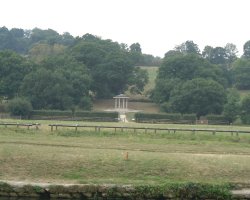 |
Runnymede and the Magna Carta Memorial Today |
In 1215, King John was compelled by the Barons to sign Magna Carta in a meadow by the Thames at Runnymede. It has been suggested that it was sealed on the adjacent Magna Carta Island, but this is a myth as the island is artificial and was not actually created until 1834. Magna Carta (Great Charter) established the principles of freedom guaranteed by law and is the basis upon which we have been governed since that time. In Clause 23 it also recognised the the right to navigate on the Thames as it stated:
"all weirs from henceforth shall be utterly put down by Thames and Medway and through all England...."
In this context, the term 'weir' probably referred to unauthorised fish traps as the original word used in the Charter was 'Kidelli' which it seems were screens of stakes and wickerwork designed for catching fish.
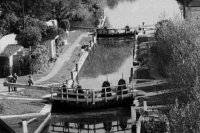 |
A Pound Lock in the 1960's Before Hydraulic Power |
As the importance of the River as a means of transportation grew, improvements were needed and by the end of the seventeenth century the first Pound Locks (the types in use today) were being built and the Thames became a major navigation route. Imported goods were transported inland from the Port of London by horse drawn or sailing barges and by the end of the nineteenth century the Thames had been linked to the canal system giving waterway access to much of England but particularly to the Midlands and Bristol.
This means of transportation was however, relatively shortlived as trade was transferred to the railway network which at that time had been expanding at an incredible rate. This demise was further compounded by the rapid growth in road transport after the First World War which really brought to an end the commercial use of the River for transportation.
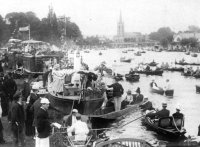 |
Ironically, it was the the growth in the railways that increased the use of the River for pleasure. There is no doubt that boating for pleasure had always been available but the railways gave more people the opportunity of cheap travel to the country from London. From the middle of the nineteenth century towns and villages such as Maidenhead and Pangbourne flourished as scores of people came to hire skiffs and punts for a day on the River. |
Afternoon on the River |
By the 1880's Steam passenger launches, such as those run by Salter Brothers of Oxford (and still running today but with diesel engines!), became a regular feature and by the 1920's private motor cruisers were quite common.(For further information about the historical use of the River for leisure see The River Thames - Hire, Trip & Hotel Boats |
 |
A Steam Passenger Launch c.1905 |
In 1885, the Thames Preservation Act was passed which was the first Act of Parliament specifically directed toward 'the preservation of the River above Teddington Lock for the purpose of public recreation and for regulating pleasure traffic thereon'. The preamble recites:
' The Thames is a navigable highway and has come to be largly used as a place of public recreationand resort: and that it is expedient that provision should be made that it should be preserved as a place of regulated public recreation'.
And it is still the pursuit of pleasure that dominates the Thames today where a variety of waterbound activities - angling, boating, canoeing, dinghy sailing, rowing etc - can all be enjoyed.
To return to The River Thames page Click Here
Copyright © The Harts